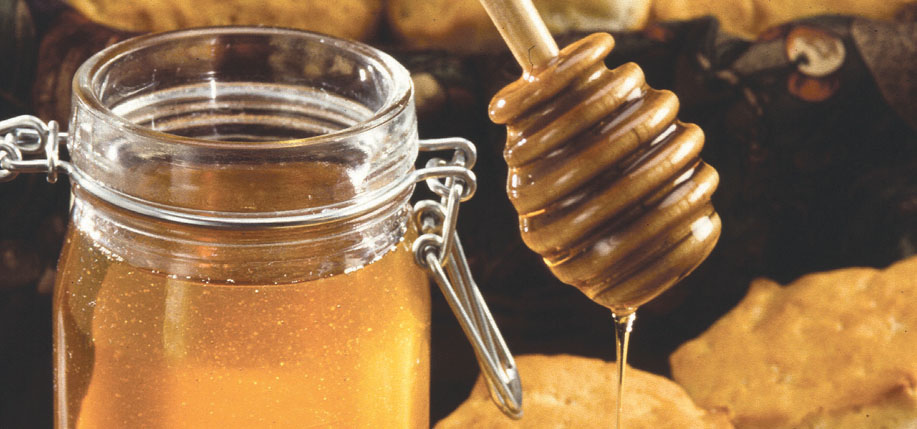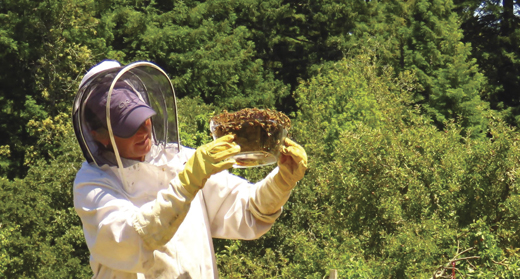One day last summer while inspecting the progress of my vegetable plants, I heard something that sounded like a giant cell phone on vibrator setting. Turning in the direction of the noise and peering under a tangled mass of grapevines, I found myself standing nose-to-buzz with a mass of bees that was considerably larger than a beachball. I freaked.
Moving as smoothly as coming face-to-face with approximately 10,000 bees would allow, I made a beeline for my computer, and immediately began surfing the net for a local beekeeping group that could come capture them. Many sites offered ‘bee control’ but they were all exterminators and I had no desire to kill any members of our dwindling bee population. Finally, I found a master beekeeper who promised to rush right over. Less than half an hour later, we traipsed out to where the swarm had been suspended, but they were gone. Not even one stray was lingering in the roses.
The beekeeper, who places hives in ‘foster’ gardens all around town, said it had probably been a swarm that had hatched a new queen and while looking for a suitable spot to hive had grown tired and paused to rest. I was much more disappointed than he. My vision of a personal supply of garden-grown golden honey, the original sweet, had up and buzzed off.
Until the 12th century when the Normans introduced costly sugared sweetmeats to the Irish table, honey was Ireland’s only known sweet. Golden heather or clover honey was added to bread dough, milk and ale. It was used to baste meat and fish during cooking, and it was served at meals as a dipping sauce.
Honey was so important in early Irish society that a section of the Brehon Laws was devoted to bees and beekeeping. There were provisions for swarms found in all locations: in a tree, in a wood, on a lakeshore or other wild place, within an enclosure, on a green, or in a herb garden like mine.
Other laws dealt with the truly puzzling question of who owned the bees and the honey itself. Anyone who found a wild hive was only entitled to part of the honey. The rest had to be shared with the people who owned the land where the bees gathered their nectar. Even when the honey was gathered from a kept hive, the owner was obliged to turn over a part of the honey to his neighbors every three years.
There was also a stipulated penalty to recompense someone who had been stung. If the victim could prove he had not killed the bee, he was owed a full meal of honeyed food.
When a woman separated from her husband, something the Brehon Laws wisely provided for, she was entitled to receive either an entire year’s production from their hive, or the swarm of bees itself. Rents and tributes to kings and chieftains were paid with honey. Two sizes of vessels were used to make these payments: a barrel so large that a very strong man could only lift it to his knees, and a smaller container that could be raised over the head. Children of the poor lived on oaten porridge and buttermilk, but the Laws required that the children of kings and chieftains must be fed daily portions of porridge made with milk and sweetened with as much honey as they could eat.
Although honey was used to sweeten and flavor many foods, the majority of any year’s harvest went into a single endeavor: the making of mead, an intoxicating beverage derived from fermented honey. The simple formula only required dissolving honey in water and exposing it to air. Eventually the mixture turned into a potent alcoholic drink. In medieval times the transmutation process was considered magical, but we now know that the chemical change occurs when airborne wild yeast spores feed on honey’s sugar content and cause the liquid to ferment.
Long ago, Royal Tara in County Meath was the seat of the High Kings. Heroes and visiting chieftains were honored at great feasts in the mead-hall where they were served cups of golden heather mead infused with the essence of hazelnuts, the nut that was believed to impart wisdom. This delicately flavored beverage is said to have been especially favored by women.
In one of Ireland’s most famous myths, The Fate of the Children of Lir, King Lir’s children, Fionnuala and her three brothers, are transformed into swans by their jealous stepmother. One of Fionnuala’s greatest sorrows is her memory of the times when she drank hazelnut mead in her father’s feasting hall. Mention of hazelnut mead also appears in the 10th century story of King Guairc the Hospitable where it is called one of the joys of hermit life.
According to a 6th century tale, Saint Madomnoc brought bees to Ireland from Wales. As the story goes, Madomnoc studied with St. David at a monastery in Wales, where he cared for the settlement’s beehives. When the time came for Madomnoc to return home, the bees loved him so much that they followed. Three times, the saint led the swarm back to the monastery. Finally, Saint David blessed the bees and gave them leave to go. When Madomnoc arrived home, he founded Llan Beach Aire, Church of the Beekeepers. The bees flourished in their new home, but ever after no bees were found at Saint David’s monastery. For centuries, Madomnoc’s feast was celebrated on February 13th with honey-flavored foods.
Another 6th century legend concerns Saint Gobnait, the Munster patroness of beekeepers whose feast is also celebrated in February. When an invading chieftain and his army descended on Balyvourney intent on stealing cattle, Gobnait met the forces holding her hand in a beehive. At the good saint’s signal, the bees attacked and routed the invaders. After the attackers fled, the bees dutifully returned to the hive.
Honey was so important to the Irish that many folk beliefs sprang up about bees. On happy occasions, people included their bees in the celebrations by tying bright ribbons to the hive. One old ditty concerning marriage states: “A maiden in her glory, upon her wedding day, must tell the bees her story, or else they’ll fly away.” Similarly, it was believed that when someone in the household died, it was necessary to tell the bees or they would swarm to another location.
An Irish-American pal, when learning I was writing this article, shared the following story with me. He had been living in an old stone farmhouse in New Jersey, and kept bees in the carriage house. When his father-in-law died, he noticed all the bees had swarmed to a small dogwood tree and seemed ready to fly away. “I went out to the tree,” he continued, “reached into the swarm to find the queen, and returned her to the hive. Then I sat on the porch and watched several thousand bees walk single file across the grass and climb back into the carriage house. It was as solemn a funeral procession as I have ever seen.” My pal is a decorated military hero and the soul of truth, so I believe his tale one hundred per cent. I just wish he had been visiting me last summer. Sláinte!
Honey Drizzle
1⁄2 cup sugar
1 cup honey
1 tablespoon lemon zest
1 2-inch cinnamon stick
2 whole cloves
1⁄2 teaspoon vanilla
1⁄2 cup water
1-2 tablespoons fresh lemon juice
Combine all ingredients in a small saucepan, bring to a boil, reduce heat and simmer for 10 minutes. Stir in lemon juice. Remove cinnamon stick and cloves. Serve warm with pancakes or oatmeal, use to sweeten tea, or drizzle over ice cream. Makes approximately 2 cups. Note: Any unused Honey Drizzle can be stored in the refrigerator, but it is necessary to rewarm it before using again to restore pouring fluidity.
Honey Lavender Milk Sherbert
2 cups milk
2 cups water
1 cup honey
1⁄2 teaspoon vanilla
1 tablespoon dried organic lavender buds, slightly crushed
Combine the milk, water, and honey in a medium saucepan. Bring to simmer over medium heat, stirring to dissolve the honey. Once it comes to a boil, whisk in the lavender and vanilla then remove from heat and cool to room temperature. Infuse the mixture for 30 minutes at room temperature, then strain through a fine sieve to remove the lavender buds and chill in the refrigerator for at least 3 hours. Transfer the mixture to an ice cream machine and freeze according to the manufacturer’s directions. Makes approximately 1 quart.



Leave a Reply